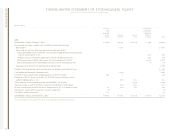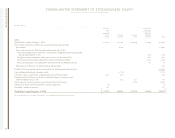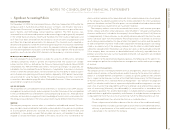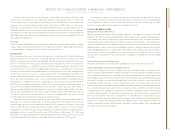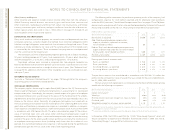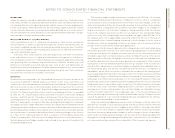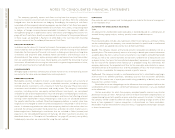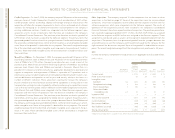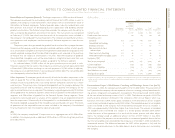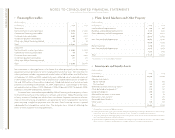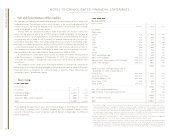IBM 2004 Annual Report Download - page 56
Download and view the complete annual report
Please find page 56 of the 2004 IBM annual report below. You can navigate through the pages in the report by either clicking on the pages listed below, or by using the keyword search tool below to find specific information within the annual report.
NOTES TO CONSOLIDATED FINANCIAL STATEMENTS
International Business Machines Corporation and Subsidiary Companies
54
ibm annual report 2004
The company generally reports cash flows arising from the company’s derivative
financial instruments consistent with the classification of cash flows from the underlying
hedged items that the derivatives are hedging. Accordingly, the majority of cash flows
associated with the company’s derivative programs are classified in Cash flows from operat-
ing activities in the Consolidated Statement of Cash Flows. For currency swaps designated
as hedges of foreign currency denominated debt (included in the company’s debt risk
management program as addressed in note l, “Derivatives and Hedging Transactions” on
pages 65 to 67), cash flows directly associated with the settlement of the principal element
of these swaps are reported in Payments to settle debt in the Cash flow from financing
activities section of the Consolidated Statement of Cash Flows.
financial instruments
In determining fair value of its financial instruments, the company uses a variety of methods
and assumptions that are based on market conditions and risks existing at each balance
sheet date. For the majority of financial instruments, including most derivatives, long-term
investments and long-term debt, standard market conventions and techniques such as
discounted cash flow analysis, option-pricing models, replacement cost and termination
cost are used to determine fair value. Dealer quotes are used for the remaining financial
instruments. All methods of assessing fair value result in a general approximation of value,
and such value may never actually be realized.
cash equivalents
All highly liquid investments with maturities of three months or less at the date of purchase
are carried at fair value and considered to be cash equivalents.
marketable securities
Marketable securities included in Current assets represent securities with a maturity of
less than one year. The company also has marketable securities, including non-equity
method alliance investments, with a maturity of more than one year. These non-current
investments are included in Investments and sundry assets. The company’s marketable
securities, including certain non-equity method alliance investments, are considered
available for sale and are reported at fair value with changes in unrealized gains and losses,
net of applicable taxes, recorded in Accumulated gains and (losses) not affecting retained
earnings within Stockholders’ equity. Realized gains and losses are calculated based on
the specific identification method. Other-than-temporary declines in market value from
original cost are charged to Other (income) and expense in the period in which the loss
occurs. In determining whether an other-than-temporary decline in the market value has
occurred, the company considers the duration that, and extent to which, market value is
below original cost. Realized gains and losses also are included in Other (income) and
expense in the Consolidated Statement of Earnings. All other investment securities not
described above or in “Principles of Consolidation” on page 49, primarily non-publicly
traded equity securities, are accounted for using the cost method.
inventories
Raw materials, work in process and finished goods are stated at the lower of average cost
or net realizable value.
allowance for uncollectible receivables
Trade
An allowance for uncollectible trade receivables is recorded based on a combination of
write-off history, aging analysis, and any specific, known troubled accounts.
Financing
Financing receivables include sales-type leases, direct financing leases, and loans. Below
are the methodologies the company uses to calculate both its specific and its unallocated
reserves, which are applied consistently to its different portfolios.
Specific. The company reviews all financing accounts receivable considered at risk on a
quarterly basis. The review primarily consists of an analysis based upon current information
available about the client, such as financial statements, news reports and published credit
ratings, as well as the current economic environment, collateral net of repossession cost
and prior history. For loans that are collateral dependent, impairment is measured using
the fair value of the collateral when foreclosure is probable. Using this information, the
company determines the expected cash flow for the receivable and calculates a recom-
mended estimate of the potential loss and the probability of loss. For those accounts in
which the loss is probable, the company records a specific reserve.
Unallocated. The company records an unallocated reserve that is calculated by applying a
reserve rate to its different portfolios, excluding accounts that have been specifically
reserved. This reserve rate is based upon credit rating, probability of default, term, asset
characteristics, and loss history.
Receivable losses are charged against the allowance when management believes the
uncollectibility of the receivable is confirmed. Subsequent recoveries, if any, are credited
to the allowance.
Certain receivables for which the company recorded specific reserves may also be
placed on nonaccrual status. Nonaccrual assets are those receivables (impaired loans or
nonperforming leases) with specific reserves and other accounts for which it is likely that
the company will be unable to collect all amounts due according to original terms of the
lease or loan agreement. Income recognition is discontinued on these receivables.
Receivables may be removed from nonaccrual status, if appropriate, based upon changes
in client circumstances.




